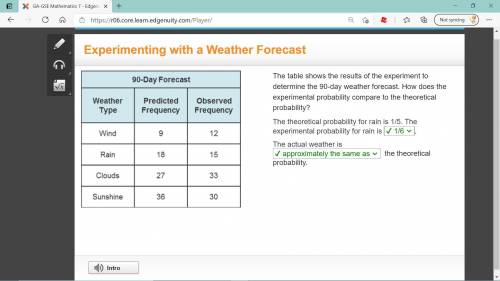
Mathematics, 10.04.2021 17:30 alexvillaa121
A 3-column table with 4 rows titled 90-Day Forecast. Column 1 is labeled Weather Type with entries wind, rain, clouds, sunshine. Column 2 is labeled Predicted frequency with entries 9, 18, 27, 36. Column 3 is labeled Observed frequency with entries 12, 15, 33, 30.
The table shows the results of the experiment to determine the 90-day weather forecast. How does the experimental probability compare to the theoretical probability?
The theoretical probability for rain is 1/5. The experimental probability for rain is
.
The actual weather is
the theoretical probability.

Answers: 1
Another question on Mathematics

Mathematics, 21.06.2019 19:00
Me with geometry ! in this figure, bc is a perpendicular bisects of kj. dm is the angle bisects of bdj. what is the measure of bdm? •60° •90° •30° •45°
Answers: 2

Mathematics, 21.06.2019 21:00
Estimate the area under the curve f(x) = 16 - x^2 from x = 0 to x = 3 by using three inscribed (under the curve) rectangles. answer to the nearest integer.
Answers: 1

Mathematics, 21.06.2019 22:30
Amachine that produces a special type of transistor (a component of computers) has a 2% defective rate. the production is considered a random process where each transistor is independent of the others. (a) what is the probability that the 10th transistor produced is the first with a defect? (b) what is the probability that the machine produces no defective transistors in a batch of 100? (c) on average, how many transistors would you expect to be produced before the first with a defect? what is the standard deviation? (d) another machine that also produces transistors has a 5% defective rate where each transistor is produced independent of the others. on average how many transistors would you expect to be produced with this machine before the first with a defect? what is the standard deviation? (e) based on your answers to parts (c) and (d), how does increasing the probability of an event a↵ect the mean and standard deviation of the wait time until success?
Answers: 3

Mathematics, 21.06.2019 23:00
An elevator travels 310 feet in 10 seconds. at that speed, how far can't his elevator travel in 12 seconds?
Answers: 1
You know the right answer?
A 3-column table with 4 rows titled 90-Day Forecast. Column 1 is labeled Weather Type with entries w...
Questions

Mathematics, 18.03.2020 17:19


Mathematics, 18.03.2020 17:19

Mathematics, 18.03.2020 17:19


Geography, 18.03.2020 17:20


Chemistry, 18.03.2020 17:20





Mathematics, 18.03.2020 17:20

Mathematics, 18.03.2020 17:20






Mathematics, 18.03.2020 17:21




